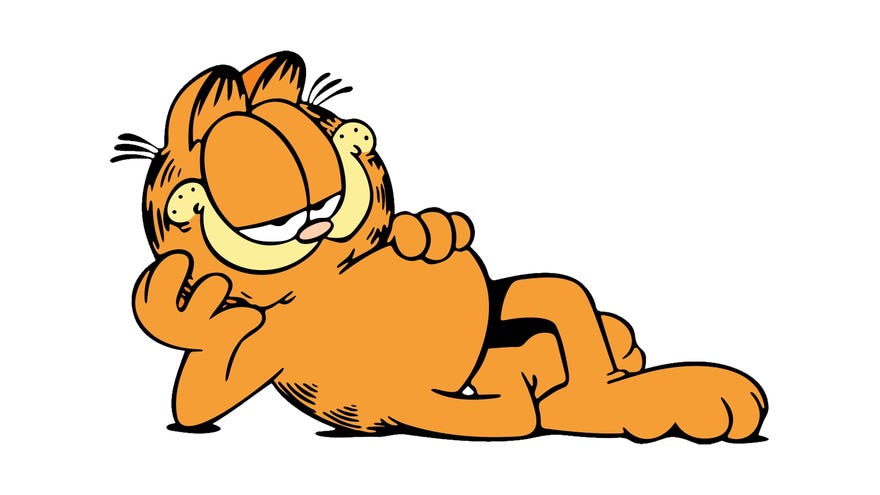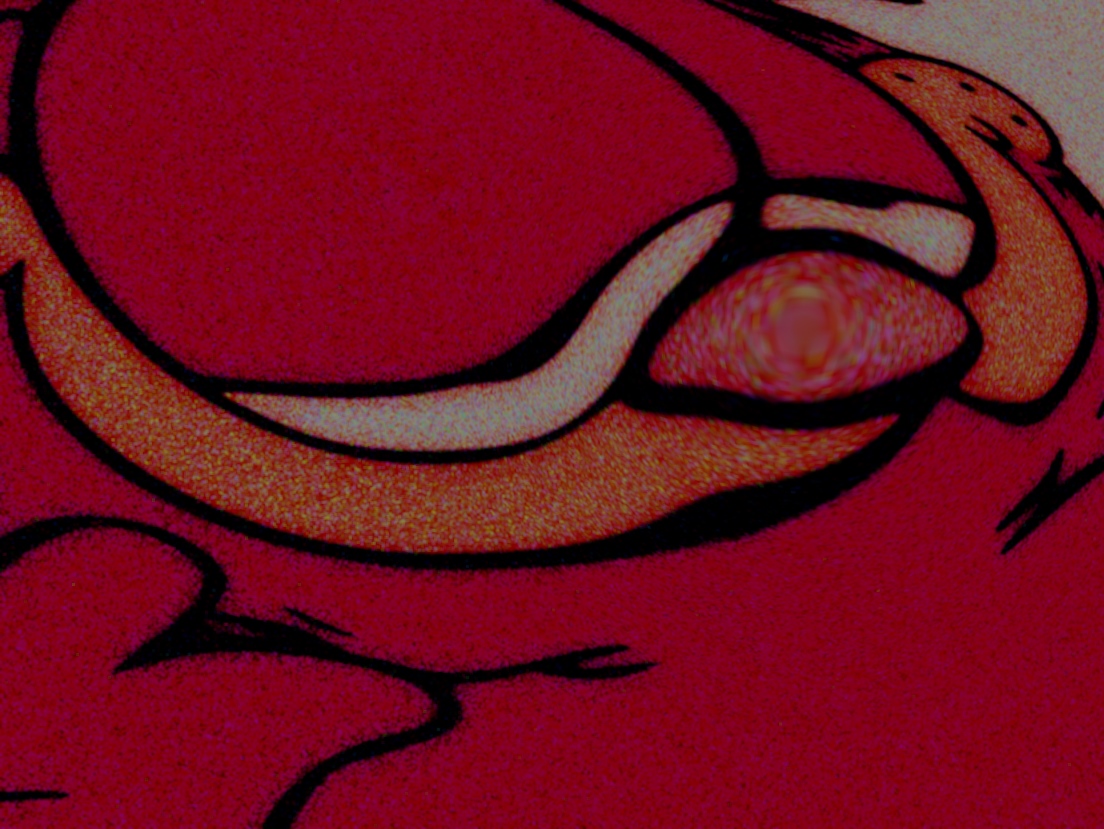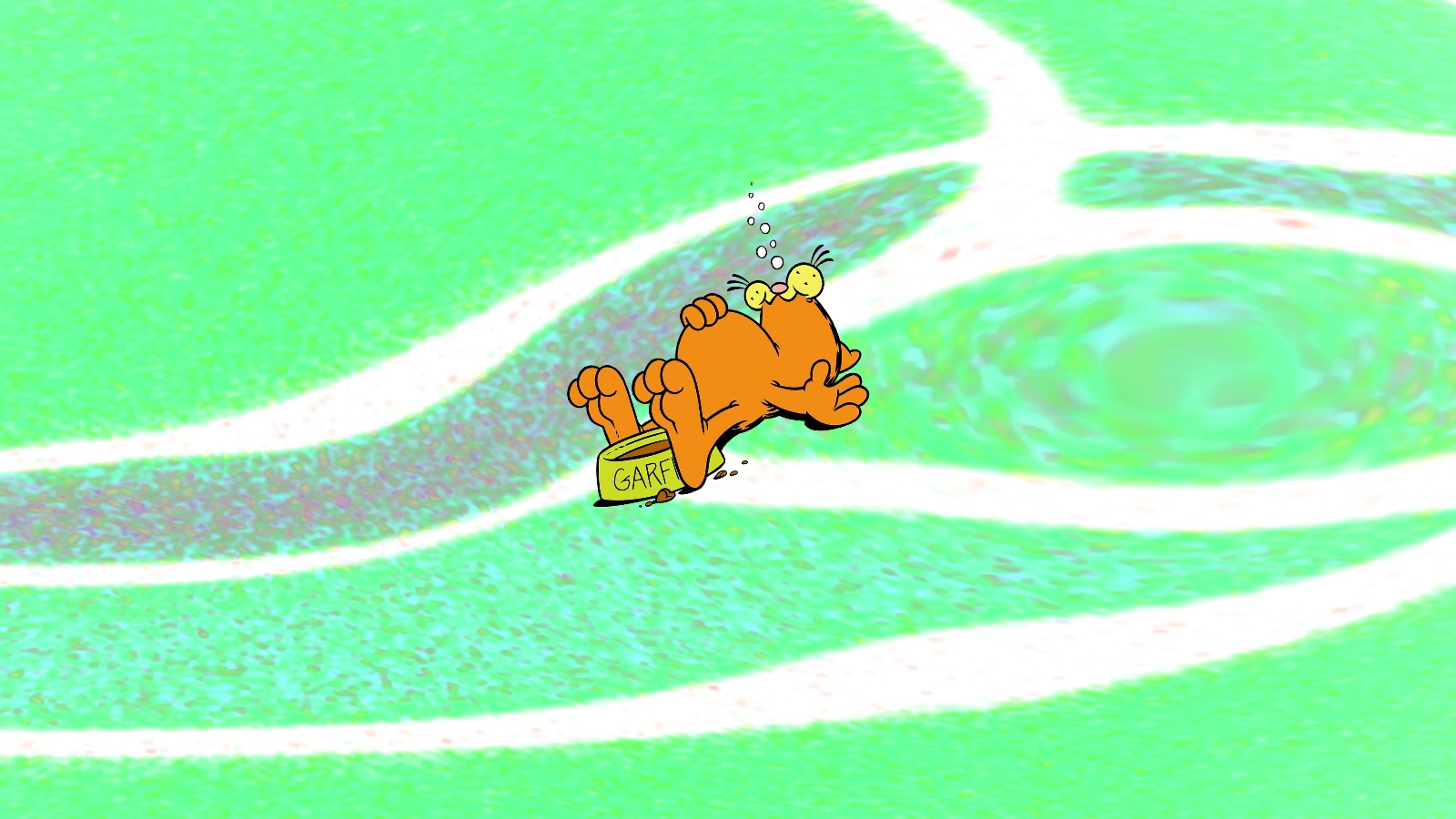Wot I Think: Garfield Kart Furious Racing
"I hate Mondays"
I cannot say, in truth, that I played Garfield Kart Furious Racing. In the plainest terms, I would say I participated in it: I offered my own myopic contribution, alongside millions of others, to form the baroque gestalt of the work as a whole. Because GKFR, you see, is a collaborative effort - directed, certainly, by its developers at Artefacts Studio, but only comprehensible as an ever-changing consensus between the game itself, its players, and its critics. In a sense, then, I am reviewing my own work - for in engaging with GKFR, I became one of its authors. And indeed, in writing as a critic, I expand the work yet further.
It’s heartbreaking, really, to resort to a term so crude as “game” to describe Garfield Kart Furious Racing. Could we call it a text, perhaps? Possibly - but one that can only be considered complete in the act of its being engaged with. According to the Copenhagen Interpretation of quantum mechanics, by observing a phenomenon, we cannot help but change it - and never has this been more true than in the case of Garfield Kart Furious Racing. In the early hours of last Tuesday, as I and a thousand others waited for the 3am activation of our review copies, GKFR existed entirely in potentia: a few million lines of code, disembodied on some server in Northern California, waiting to be defined through our shared experience. A sealed box, if you will, containing a cat.
Only when that box was opened, could we know if the cat was Garfield. Only when this art was sullied with our own digital hands, could it be real. To think now, that all the genius, all the singular agony of the work, was condensed into just a few million lines of alphanumeric shorthand, is as hard to comprehend as the information required to build a human being archived in the chemical broth at the heart of a cell. Less of a game, then, and more of a gamete - at least for that moment. It would require us, like the mass of cells teeming in a growing zygote, to transcribe genotype into phenotype.
And we were ready: a legion of us, fingertips crackling above our keyboards with the electricity of anticipation, as we awaited the crucial hour. Time crawled. But if Garfield Kart Furious Racing says anything unambiguously, it’s that the clock can never be stopped. And indeed, it was not: 3am arrived, the code was activated, and the players began to race.
Before we get into the thick of it, however, one more short note on terminology. Just as I am loathe to call Garfield Kart Furious Racing a ‘game’, so too am I unhappy to call us ‘players’. I will do so only in the archaic, theatrical sense of the word. For if physics is one way to codify the business of magic, then theatre is another. The text of a play is a spell: an invocation of power, but one which cannot take full effect until imbued with physicality by performers on a stage.
Our PCs were the stage, and our mouse clicks were the words of power, affecting the will of Garfield Kart Furious Racing in its desire to be told to the world. Even then, were we thespians, using our own talents as fulcra against which to shift the weight of GKFR’s genius? Or just a pantomime mob, amplifying every emotional peak and trough with our animal passion and noise? At times over the four days of the review period (during which, I think, I spent all of 20 hours away from my gaming chair), both felt true.
Sometimes, I loved the other racers - they were fellow pilgrims; the only people who could relate to the intensity of what I was experiencing with Garfield Kart Furious Racing, and the only people who could diffuse its pain, by the certain knowledge that they shared it. Other times, I despised them. Wretched and capering, they were beasts; mean apes with funneled lips and grasping hands, boneheaded enough to be treating this as a knockabout competition; a bit of fun. Garfield Kart Furious Racing showed me the best of myself, and the worst of myself.
For a while, it would lead me to a place where I felt very lost indeed. Where I felt genuinely frightened, if I am honest. But the darkness was necessary, I think: a rocky shore, shrouded in haggard gloaming, for GKFR’s final revelations to bring dawn to. But I get ahead of myself. At first, of course, it was gloriously simple - we raced. We raced, in randomly assigned cohorts of eight, and for three laps per track, in go-karts driven by the most beloved characters from the Garfield franchise. There were comedy items to pick up, hats to collect, muffled voice lines to blurt - you know the sort of thing.
There was a sort of cruel smirk to it all: “let’s pretend,” the game seemed to drawl, “that this is one in a series of overpriced iterations of a slapped-together kart game from 2013, which itself was conceived joylessly on a whiteboard, through the rubbing together of the phrases ‘Mario Kart’ and ‘profit?’, lubricated by the application of the most qualitatively bankrupt intellectual property that pocket change can buy.”
We all laughed, of course, at this implicit satire. And as if in demonstration of its ability to master comedy as well as tragedy, Garfield Kart Furious Racing knew exactly how long to drag the joke out for. Soon, of course, the primary-colours incompetence of these early stages would begin to blur and warp. New races would begin the moment existing ones finished - or even before that, with in-progress races vanishing, and smash-cutting to others in media res.
Other players took this for bugginess, but I - being familiar with the prior form of Artefacts Studio founder Pascal Enigmé - suspected otherwise. When players from our now-familiar racing groups began disappearing, replaced by drivers with unfamiliar usernames and erratic behaviour who refused to enter chat, my suspicions grew deeper.
Our little assigned octets, although fiercely competitive, were like family after hours of play. To have our brothers and sisters yanked away like this, replaced with interlopers who might not even have been human, sowed a pervasive disquiet. As it turned out, this was to be just the beginning of the game’s gradual, cosmic self-deconstruction - and be warned, here, for there are major spoilers ahead.
I think I only realised how far things had gone when, around eighteen hours in, Odie died. Ever stuck between being Garfield’s nemesis and his best friend, the wordless, mouth-necked hound was loved and despised in equal measure. One thing at least was indisputable: he was, alongside Jon and Lasagna, the only fixed point in the protagonist’s world. And then, without warning, a colossal, leaden bell rang out, and for the first time since we had started racing, the game froze. Across hundreds of races, players shouted out in horror on chat as the world faded to chilly greyscale, and Odie’s kart was slashed over with a crude red cross, before fading into nothingness. Shockingly, at that moment, everyone playing as Odie in the affected races was booted from the game on a permanent IP ban - they were given only thirty seconds to say their farewells to their fellow players, before Garfield Kart began permanently deleting itself from their hard drives and their Steam libraries.
“This is real consequence,” Enigmé seemed to be saying through his opus. After years of so-called ‘roguelikes’, with their ever-diluting attempts to convey the permanence of loss to players, Garfield Kart Furious Racing was finally slaughtering one of gamings’ sacred cows: the idea that, in some manner at least, there should always be a chance to try again after death. As the karting stopped for a full hour so players could conduct Odie’s funeral - each set of racers had to improvise their own ceremony in an extended, sombre RPG minigame - the reality of what we were doing really began to sink in.
Of course, those of us with our eye on the unfolding narrative saw it coming. Enigmé’s stories are famously hard to follow - they are told outside of linear chronology, and often rely on oneiric leaps of dream-logic to connect sequential events - but they rarely stray from instinctive, emotional truths. It’s magical realism, of a sort, and I for one believe the rumour that, just two years before his death in 2016, the writer and semiotician Umberto Eco collaborated with Enigmé to produce, as his final work, a draft screenplay for Garfield Kart Furious Racing.
Of course, one suspects the story may have become less… sober as a result of Eco’s passing. Enigmé adores painting with the lurid colours of low culture; he is in love with impenetrable worldbuilding, and can’t resist deploying bombast and spectacle to distract from the melancholy delicacy of the real points he’s making. Hence the convoluted science fiction plot, which began appearing in allusion and brief cutscenes around the seventh hour of play, but which became explicitly foregrounded after Odie’s demise.
The “Furious Racing” of the game’s title, it turns out, is an allusion to the famous line by the poet Taber Fyshe, and refers to a scheme by Garfield to free the universe from the concept of death itself. His plan is to engrave a series of sigils on the fabric of reality through the unceasing movement of go-karts around a number of tracks, each planned according to the Lasagna-loving cat’s understanding of astromancy. Amazingly, it would later transpire that each player assigned to race as Garfield knew this from the start of the game, but was forbidden from letting on to their competitors.
Of course, Garfield’s plan has a price: over time, the arcane energy of the race fuses the bodies and the souls of his friends with the fabric of their go-karts, increment by unnoticeable increment, until they become tortured, bestial hybrids. They have escaped death - but only in as much as they can no longer truly be described as alive. As their bones merge with the chassis of their karts, they become wilier, able to phase briefly through other vehicles and bend corners with their combustory susurrations: it’s classic Artefacts Studio, offering a perfect, Faustian balance between sacrifice and reward.
Odie’s demise, it turns out, is an act of mercy by a mysterious third party, who couldn’t bear to see him live out that grim fate. As the story progresses, they seek to thwart Garfield at every turn, recruiting players to their cause (and thereby explaining where those mysterious racers had come from earlier).
At first, it’s hard to know whether to trust them, or the famously lazy orange cat. As it becomes clear just how insane Garfield has become in his pursuit of noble aims, however, the game pivots decisively. Before long, everyone is working together to halt the Furious Racing and restore the natural order of death, even as they slowly merge with their vehicles and lose their minds.
Indeed, this is a game riven with such gradual but colossal transitions. Its music, which starts as a series of merry synthesised whoops and bleeps, changes note by note, and layer by layer, until it emerges late in the game’s second act as a sweeping, heart-wrenching score by Game of Thrones and Westworld composer Ramin Djawadi. Djawadi is the perfect choice for Garfield Kart Furious Racing, as the quality of his work mirrors the mix of high skill and low culture - the sheer inherent bathos - of Enigmé’s own.
The very nature of play makes even more drastic transitions. Clearly, Garfield Kart Furious Racing begins as a kart racing game, and at the very end it’s also a karting game - although explaining how, would give away the perfection of its final twist. In between these two endpoints, forming a sort of delicious chiasmus, the game becomes an RPG, a narrative-heavy puzzle game, and a sort of tower-defence business. The brief, mind-blasting central spell in which the world opens out, connecting together the racetracks of every player group at the same point in the story, is almost too much to bear - when the game starts reversing back through the genres again, it’s a true relief.
(Here’s yet another genius thing about Garfield Kart Furious Racing, by the way: it forms groups of players based on the commonality of what they’ve experienced so far - and will even nudge the plot, shifting expository cutscenes on the fly in order to herd together larger and larger groups towards simultaneity, so they can experience the game’s larger set pieces - such as Odie’s Death, or the battle of the Timehammer - as a community. Of course, this means that some players will have shorter games, and others longer, as GKFR’s storytelling AI trims their experiences to match those of others. But isn’t this, in itself, a pretty strong reflection of the wildly varying hands we are dealt by life itsef?)
Of course, a work of such byzantine complexity as this could not be hoped to function bug-free, and some sections - clearly coded against the clock on the insistence of the notorious perfectionist Enigmé - really suffer from having been brute-forced into the game. Like other reviewers, for example, I found myself nearly quitting in exasperation during the “reign of the Tarmac Duke” segment, at around most games’ thirty-hour mark.
The Duke, a morose giant who wears nothing but an iron helm full of live spiders, is meant to be a sort of asymmetric threat for the racers - controlled by a baffled player who thought they had purchased another game (Artefacts' “Formula War”), the idea is that he lopes behind the pack of karts, seizing anyone who lags behind and forcing them to drink from his champagne bottle full of live spiders.
The problem is, his hit box is all over the place, and the crossplay issues involved in getting him in game (Formula War was a PlayStation 3 exclusive) lead to monstrous levels of rubberbanding. As a result, throughout the entirety of the Duke’s section of the game, he can appear without warning, wildly distorted and clipping through scenery, shaking spiders down your throat in monotonous quicktime events that can’t be skipped. Perhaps this is another facet to the game’s conversation with the idea of inevitability, but I’m not entirely inclined towards giving it the benefit of the doubt.
Then there was the bit where the game paused, and wouldn’t resume unless at least one racer was microblogging about Garfield using the in-game web browser. It was a great idea in theory, leading to some interesting dilemmas about altruism - would you scupper your race performance by blogging as you drove, thereby letting the race continue for everyone? - but the technical problems were near-insurmountable. Artefacts, suffice to say, should not go into the business of designing web browsers.
Then of course there were the Warlock Cubes, which were harmless enough, but never really functioned as intended, and the Blood Moon segments, which if I’m honest I think may have been entirely broken beyond the appearance of a vast, crimson Garfield face in the skybox from time to time. And of course, the Tiger-Haunted Prison. The less said about that the better.
But hey: you can’t make a massively multiplayer, narrative-driven, genre-busting racing game that manages to wrestle with the fundaments of existence, without breaking a few eggs. I forgive Garfield Kart Furious Racing for all these things, and I would forgive it much more besides. Indeed, after its indescribable denouement, I think I’m beginning to understand the very concept of forbearance in a whole new light.
But where to conclude? How to say something new - something definitive - when so much has already been said in the scant days since the release of Garfield Kart Furious Racing? I’ve not been a professional games reviewer for that long, and I’m not ashamed to admit I was frightened by the prospect of offering my opinion, publically, on a work of this size and importance. Truly, this is a Monday to hate more than any other.
Perhaps, then, it’s best to throw all sophistry to the wind, and speak the most basic truth in my heart, as Odie would have done, had he only been able. So here goes: this is the best bit of software that has ever been created. Forget football: when we speak henceforth of “the beautiful game”, we shall be speaking of Garfield Kart Furious Racing.
















